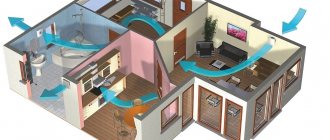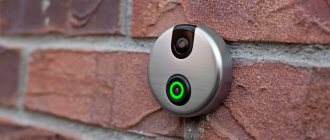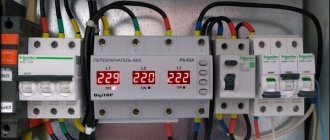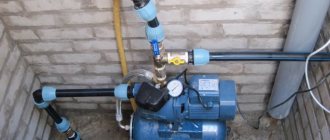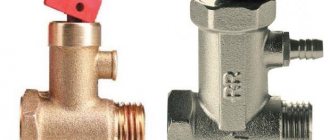We cook in the kitchen every day. If in summer you can ventilate the room using an open window, then in winter a high-quality built-in hood with a carbon filter will help eliminate odors, grease, and fumes.
Built-in hoods have a number of advantages:
- they do not require connection to the ventilation system,
- compact, as they do not require a large dome and a hole for a pipe to remove air,
- The filter is easy to replace with your own hands,
- are easily and quickly mounted on fasteners.
The hood with a carbon filter without outlet has a cassette carbon element, which is presented in the form of a cartridge of different shapes. The cartridge body contains carbon powder or small granules.
Carbon filters are used for fine cleaning and odor removal.
Operating principle: air is captured by a fan and forced through the coal. The granules absorb gases from polluted air, thereby purifying it.
The device is valid for about three to four months. Some hood models are equipped with a contamination indicator that signals the need for replacement.
Where is the carbon filter located in a kitchen hood?
Carbon elements in equipment without air exhaust are installed immediately behind the grease filters. This is explained by the fact that it is first necessary to clean the air of fat particles, and only then of odors and other contaminants. In this way, a comprehensive cleaning is performed.
Before replacing the carbon filter in your kitchen hood, read the manufacturer's instructions. Usually replacement is needed once every 3-4 months, but in some models of hoods it is enough to do this once a year. It is also necessary to take into account the intensity of use of equipment and the level of air pollution.
- To replace, you must unplug the equipment and remove the air intake mesh.
- The next step is to dismantle the fat element and remove the filter cassette from the slot.
- All that remains is to remove the contaminated carbon element and install a new one in its place.
If you see that the carbon filter housing can be opened, then you can manually change its contents, that is, add fresh activated carbon granules.
VIDEO REVIEW » alt=»»>
What do you need to know before you start cleaning?
Simply wiping the outer part of the body with the buttons does not mean washing the hood. The device will have to be partially disassembled, and in order to do this correctly, you will need to look at the instructions, which indicate all the design nuances and disassembly rules for a specific model. In general terms, the process of preparing the hood for cleaning is as follows:
- de-energize the device;
- Unclip the latches of the top panel (if equipped) and remove the grease filter. It captures grease particles well and does not need to be replaced - only regular cleaning. The grease filter is usually made of steel or aluminum. The steel option is the best. There are disposable grease filters that are used in the most compact hoods. They are made on the basis of paper, acrylic, padding polyester or non-woven fabric, and need to be replaced every 3-4 months, they cannot be washed;
- remove the carbon filter that is equipped with circulation-type hoods. The carbon filter cannot be washed - it needs to be replaced as it becomes dirty. On average, it is changed every 4-6 months.
Flow-type hoods remove drawn-in air through a ventilation duct to the street. A grease filter is necessary to protect the motor. In this type of hood, cleaning the ventilation duct is sometimes required. Circulating hoods draw in air, clean it and send it back to the kitchen. The cleaner the carbon filter, the more efficient the process, so you should not forget to change it.
What and how to clean the kitchen hood from grease? It all depends on the degree and age of the pollution. Someone will get by with little blood, i.e. the most common detergents, while others will have to work hard using aggressive chemicals.
How to install carbon filters in a hood
All carbon elements are disposable and can be included with the hood or purchased separately.
The process of installing a carbon filter is similar to the replacement scheme. Those who do not know how to remove the filter from the hood should follow the algorithm below.
How to replace a carbon filter in a hood
- The first step is to disconnect the hood from the mains to avoid accidentally turning on the motor.
- Then you need to remove the anti-grease element and take out the cassette, which is intended for the carbon cleaner. Insert the charcoal cassette into the mounts until it clicks.
- Next, replace the anti-grease element.
- All that remains is to connect the device to the network and make sure that it works properly without noise and vibration.
Thus, installing a carbon filter in a hood is not a difficult task, and it is quite possible to cope with it without the help of specialists.
In order for the equipment to work properly, it is worth taking care of proper care. To do this, do not forget about cleaning the grease trap element and timely replacing the carbon one.
In order to wash the grease filter, you must:
- remove it from the equipment and place it in a basin or bathtub,
- fill it with detergent and clean it with a brush, pour boiling water over it,
- If cleaning with detergent does not work, use a solution of soda and laundry soap, soaking the filter in it for 3-4 hours.
After drying, the fat element can be replaced.
Is there a universal filter for charcoal hoods?
Today, universal carbon elements are quite popular, which can be used in almost all types of hoods in recirculation mode, that is, when there is no connection to ventilation.
Many people buy universal carbon filters for Elikor hoods made of non-woven fabric - polyester. The fabric is impregnated with activated carbon and absorbs odors and fat well. Filters from this manufacturer are affordable and suitable in cases where the hood is not used often.
VIDEO INSTRUCTIONS » alt=»»>
Which is better, a charcoal or grease filter for a hood?
Often, air exhaust hoods make do with only one filter – a grease filter, but for complete air purification it is still recommended to install a carbon one. How are they different from each other?
The fatty one performs rough cleaning and is designed to trap large particles of fat and soot that can damage the motor blades. The fatty element also protects the inner walls from oil vapors. Absorbs up to 96% of fat particles and unpleasant odors.
Coal ones are intended for fine cleaning; it is no coincidence that they are called anti-odor or absorption. Absorbs gases, harmful impurities of steam, odors.
Fat disposables are made from synthetic fibers, for example, acrylic, padding polyester, non-woven fabric. Used in inexpensive hoods. They cannot be cleaned and therefore require replacement.
Reusable ones are made of metal and mesh foil - symmetrical or asymmetrical. For production, stainless steel or galvanized steel with a protective layer against oxidation is used. Reusable ones are more practical; they are easy to wash by hand or in the dishwasher. Used in more expensive hoods.
- Let's look at several models of grease filters on the market.
Lissant-yug produces cassette versions suitable for use at temperatures up to +70C. They are non-separable, made of galvanized or stainless steel with a thickness of 0.5 mm. The filter element has five plates.
Manufacturer Roven offers customers a one-piece prefabricated structure made of stainless steel or galvanized steel that can withstand temperatures up to +80C. The filter element has three or five plates.
The manufacturer Titan produces options made of stainless steel with a thickness of 0.5 mm and a working environment temperature of up to +70C.
- Carbon filters are all disposable. The degree of filling may vary. The denser the coal, the lower the throughput. The shape can be round, rectangular, concave, flat. The body is usually made of plastic.
Buyers can order a carbon element of the desired size or purchase a standard one.
The range of hoods with a carbon element is very large. Thus, carbon filters for hoods are Hansa , Gorenje, Krona, Electrolux.
It is impossible to unequivocally answer the question which one is better, since it is necessary to use them simultaneously. In this case, high-quality and complete air purification will be ensured.
Where to buy a carbon filter for an exhaust hood - review of manufacturers
Let's consider different options for hoods with carbon purification systems from popular manufacturers.
- The Italian company produces hanging corner, wall-mounted and built-in models. They are characterized by low noise levels, ease of installation, and original design. Control can be either push-button or touch. The cost of equipment starts from 28,000 rubles, and the price of filters starts from 1,000 rubles.
- produces hoods with push-button and slider control systems. The equipment is silent and quite easy to install. The cost of the equipment is quite affordable and starts from 3,000 rubles. The cost of carbon filters starts from 400 rubles.
- Hansa brand products are deservedly considered one of the best on the market. The technology is economical, easy to use and inexpensive. Hansa filters are sold at prices starting from 2,900 rubles.
- produces built-in and wall-hung models equipped with a metal and carbon filter. They are characterized by economical energy consumption. For our own equipment, carbon elements are also presented, which are selected according to size for a specific model.
Installation method
There are four different ways to install a kitchen hood. Before purchasing a product, you should figure out which model is suitable for a specific kitchen.
- Flat hood. This model is a thin panel of small size. Installing the exhaust system is extremely simple - it is mounted above the hob perpendicular to the ceiling. This option will be a great addition to a small kitchen. Due to its low power, this hood is unable to filter a large volume of air.
- Hanging system. Based on the name itself, you can guess that this hood is not attached to walls or furniture. It can be hung from the ceiling or from furniture. This design of the exhaust system is suitable for a kitchen that is located in the center of the room, that is, not adjacent to the walls.
- Inclined hood. This design is one of the comfortable and modern ones. The inclined hood is quite powerful and does not interfere with the cooking process at all. In addition, this model is one of the hoods with minimal noise production. This is a convenient and practical option for any kitchen, which has won a large number of positive reviews.
- Built-in hood. Such systems are characterized by the greatest power. They are easily mounted into furniture, remaining almost invisible against the background of the overall interior. You can see such a hood by looking under the cabinet in which it is built.
1 Purpose and types of filters, differences and prices
There is a wide variety of kitchen hoods. Each hood can be equipped with two types of filters:
Coarse cleaning includes grease filters that trap fumes and soot, as well as small particles. Their main purpose is to protect the internal parts, the walls of the air duct and the hood itself from grease and soot.
Grease filters can be either disposable or reusable. Disposable ones are made of acrylic and non-woven fabric. Reusable grease filters are made of steel and aluminum.
There are several types of grease filters on sale:
- The acrylic filter is simple and reliable to maintain. You can buy it at a price of 93 rubles;
- Paper filter - it consists of non-woven fabric, disposable. You can purchase it at a price of 255 rubles;
- Aluminum filter – reusable, easy to clean, made of perforated aluminum. Requires very careful care. Its price starts from 1,100 rubles;
Step-by-step installation of a carbon filter
It is recommended to wash or replace the grease filter for the hood on time. If this is not done, the load on the hood motor may increase and, as a result, its performance will decrease. Many grease filters have a replacement indicator, making it easy for you to know when the filter needs to be replaced.
Exhaust fans
Powerful lamps become very hot, causing the air to become dry, which has a detrimental effect on the development of plants. Exhaust fans are used to remove heated dry air, as well as to bring fresh air into the room with plants. It makes sense to install them in the upper part of the room, because warm air, according to the laws of physics, rises.
To determine the approximate required fan power, let's turn to a simple formula: divide the lighting power in watts by 2 - we get the approximate number of cubic meters of air that the desired fan should blow out in 1 hour. To the obtained value we add 20% (power spent if a carbon filter is connected). In practice it looks like this:
400:2=200
200+20%=240
Answer: 240 m3/h.
If there are several light sources (DNAT 400 watt + ESL 125 watt + OSRAM Fluora 36 watt (2 pcs)):
2 Features of carbon filters for hoods
Hoods with a carbon filter are sorption devices, their purpose is to eliminate odors in the room. They are capable of trapping vapor impurities and harmful gases. Cleaning the carbon filter is impossible, which is why it must be replaced frequently within the time limits specified by the carbon filter manufacturer.
This filter is made on the basis of activated carbon. Such filters are treated with a chemical composition that helps the carbon filter rid the kitchen of unpleasant odors and burning. Hoods with a carbon filter are cheaper than their analogues.
Carbon filters are used not only in hoods, but also in ventilation systems and refrigerators. Carbon filters for ventilation are used to remove gas impurities from the supply air mass.
- You can buy a carbon filter for ventilation “Phresh 1000 m³” at a price of 13,781 rubles;
- "Akpo" universal carbon filter you can buy for a price starting from 440 rubles.
A carbon filter for a refrigerator is used to eliminate unpleasant odors in the refrigeration unit. The main filter for water purification is widely used in everyday life. The main filter can be installed in various household appliances, for example, in a dishwasher or washing machine. They purify water from: chlorine, iron, sand and scale.
- You can buy a carbon filter for a refrigeration unit at a price of 700 rubles;
- You can buy a carbon filter for exhaust equipment “Elikor” with a rectangular shape size: 570 x 470 mm at a price of 600 rubles;
- The price of a carbon filter for the Elikor F-00 hood starts from 900 rubles;
- The price of a carbon filter for hoods starts from 1200 rubles;
- The Geyser Jumbo main filter is used for water purification, price from 1,560 rubles;
- Main filter "Geyser" against scale 1pf 32063, price from 340 rubles.
2.1 How to choose and install a hood with a carbon filter?
If you want to purchase a kitchen hood with a carbon filter, it is better to buy a flat type hood, as it is the most compact among its analogues. The hood operates in recirculation mode. This happens in the following way: the air mass enters the hood and is cleaned by the filtration system, which is built inside the hood, and then the purified air flow again enters the room.
The disadvantage of this hood is that over time, disposable filters become dirty and require frequent replacement of the carbon filter. When choosing an exhaust device with a carbon filter, you need to pay attention to its performance. The more powerful the engine, the more powerful the performance, but the disadvantage of a powerful engine is the high noise level during operation. The standard noise level should not exceed 55 dB.
Description of grease traps
There are several groups of devices for filtering fumes in the kitchen. The principle of their operation is based on the absorption of fat and soot particles. For this purpose, the composition contains synthetic fabric.
It is able to perfectly clean the air flows that the fan sucks in.
Grease trap groups:
- flat elements for single use;
- aluminum mesh, divided into many small cells and encased in a rigid frame;
- similar products, but made of stainless steel.
Replacement models resemble a thin carpet in appearance. They are usually used in small built-in hoods. Synthetic fiber or paper is used for cleaning here. In the first case, it can be padding polyester, acrylic or non-woven fabric. This product can last a maximum of 3 months, but with careful handling. This means that the device should operate no more than 2 hours per day.
Aluminum models
The grilles, made of aluminum or stainless steel, are adjusted to the dimensions of the household appliance. They are good because they are suitable for long-term use. They operate on a simple principle: the smallest mesh cells, which are placed in a frame, trap flying particles.
There are several advantages and disadvantages of such products. For example, a disposable grease filter cleans the air well, which protects the surface of the duct and fan from sticky grease and plaque. The downside is that it doesn't last long. The problem of removing any contaminants can only be solved by replacement; washing and drying the material does not bring any benefit. The cost of the purifier depends on its size. The minimum price is 150 rubles.
Replacement Parts
Replaceable inserts are sometimes suitable for universal use, that is, they can be installed in any ventilation devices where the use of these elements is provided. Long service life is typical for stainless steel and aluminum components.
According to the technology, they can be cleaned with water with the addition of various detergent compounds. But when compared with the replacement version, a new catcher with a mesh structure will cost at least 2 times more. At the same time, it is characterized by a crude air purification system. After about a year of use, drops of fat cover the surface of the case. You can also notice them on the outlet channel and internal cavities of the device.
Types of kitchen hoods
The hood is an important element in ensuring normal ventilation in the kitchen. The speed at which odors are removed from the room depends on its effectiveness.
Carbon filters are a mandatory component not for all types of hoods, but only for recirculating ones, so let’s first remember what types of air purification devices there are in the kitchen.
According to the method of air flow, all hoods can be divided into three categories:
- flow-through;
- circulation (recirculation);
- combined.
Flow hoods are connected to the ventilation duct using a rigid or flexible air duct.
The air containing kitchen fumes enters the hood and then into the ventilation. Various types of flow-through devices are also equipped with filters, but their function is slightly different - to protect the motor from an aggressive environment.
Recirculation devices do not require air ducts.
The air flow in the circulation model comes from the stove into the housing, passes through 2 cleaning stages (2 types of filters - anti-grease and carbon), and then returns to the kitchen space.
Combined models have an additional recirculation function. That is, you can insert carbon filters and start the recirculation mode, or you can connect an air duct and use the flow function.
Advantages of a recirculating hood
The question immediately arises: why buy a hood with filters (and this is an additional expense), when you can simply install a model with an air duct that does not require annual investments?
In fact, recirculating hoods are very popular due to the following advantages:
- Autonomy . The device does not require a ventilation system to operate. If the exit to the ventilation shaft is in the opposite corner, you don’t have to worry about the design of the air duct, but simply install a model with a carbon filter.
- Compactness. The housing takes up a minimum of usable space above the stove, and its “working” part easily fits in a small cabinet. With sliders, the surface does not protrude beyond the border of the cabinet until it is time to turn on the device by sliding the panel over the stove.
- Heat retention. In winter, when the outside temperature is below zero, frequent ventilation threatens heat loss in the apartment. When using a hood with filters, there is no need to open the vents (unlike flow-through models, which require air flow).
- Easy to install. The hood is inserted into a cabinet suspended above the stove or simply attached to the wall. There is no need to create either an air duct or hanging structures to disguise it.
- Easy care. To ensure that the functionality of the device does not suffer, you need to change the carbon filters on time and periodically clean the anti-grease filters.
The cost of recirculation models can also be considered an advantage, since it fits well within a modest budget - on average from 2,200 rubles. up to 5000 rub. Plus, about once every six months you need to purchase a carbon filter, which will cost 350-900 rubles.
Additional information about recirculating hoods, their application and installation features is provided in the articles:
Frequently asked questions from buyers
It is believed that flow hoods remove 100% of unpleasant odors from the room, while recirculating hoods operating on carbon filters remove much less. In fact, it is impossible to remove all odors from the kitchen, since they spread very quickly to neighboring rooms.
The difference in performance between the two types of hoods is about 15-20%, that is, carbon filters clean the air quite well.
Exhaust equipment with new carbon filters, when used correctly, works in such a way that it protects wallpaper, tiles, ceilings and furniture from grease and other deposits
Many people do not want to constantly spend money on consumables, and instead of hoods with carbon filters, they buy a model with an air duct, believing that in the end it is cheaper.
To calculate the costs, you need to add the cost of cartridges to the cost of a recirculating hood - for 10 years, on average, you will need about 20 pieces. And to the price of a flow-through model, you must add the payment for materials (ducts, corrugations, fittings) and services for installing the air duct. Additionally, you should take into account the cost of the suspended structure, if it is required for camouflage. It remains to compare the results.
Also, in order to save money, enterprising owners of hoods, instead of the hard plastic cassettes recommended by the manufacturer, manage to put soft fabric filters into the housing, which cost 5 times less. This is a gross violation of the use of exhaust equipment.
Homemade and refurbished filters sharply reduce the performance of devices, and also do not provide any guarantee that the engine will function for the required period after such “protection”.
You can often hear the question: is it possible to use non-original cassettes and panels if there is no corresponding brand? Of course, it is possible, but under one condition - if they are suitable in composition and size. This is easy to do by carefully examining the packaging: the names of the models to which the cassette or cartridge fits are usually indicated directly on the front side.
Design and principle of operation of a carbon filter
The appearance of the filter may vary, as it is made of either plastic or synthetic fabric. In the first case, it is a round or rectangular plastic cassette filled with activated carbon in the form of powder or granules; in the second, it is a dense piece of material impregnated with the same activated carbon.
Sometimes these two types are combined to create more effective protection against hot vapors and impurities that pass through them.
Carbon filters should not be confused with anti-grease filters, which are a metal mesh or grate and are the first stage of protection. Particles of fat and substances settle on the anti-fat barrier - this is a kind of coarse filter, but it does not retain odors.
And the charcoal filter passes through air that has already been cleared of grease, and this is what eliminates unpleasant and pungent cooking aromas.
When choosing replacement units for your hood, you should follow the manufacturer’s recommendations. The fact is that in order to increase the demand for products, most of the filter cassettes and cartridges are universal in nature, that is, they are suitable not for one specific model, but for several. The list can contain up to 20 items.
You should ask the seller about the availability of consumables before purchasing a hood, otherwise you will soon encounter an unpleasant situation. After six months or 3-4 months (the service life is indicated in the instructions), you will want to purchase replacement cartridges, but you will not be able to find them on the open market.
This is especially true for the latest models that have just appeared on the market. If the problem has already occurred, try looking for a replacement in online stores.
Operating principle of coal protection:
- First, the air passes through a dense layer of viscose soaked in a charcoal solution. Some of the impurities and fat remain in the fabric structure.
- The partially purified air is then directed into the cassette where the granules are located. Activated carbon has remarkable properties - it not only traps residual impurities, but also absorbs specific odors.
Several cleaning cycles completely free the air flow of dirt and kitchen aroma. When the properties of the filler, “clogged” with grease and dirt, decrease, a new filter must be installed. In this regard, devices with sensors that indicate the need for replacement are very convenient.
The most common mistakes when cleaning the filter
Cleaning the filter is not difficult. But even here you can make fatal mistakes that will lead to replacing it with a new one. Most often, the wrong product is chosen to remove dirt and grease. It could be:
- If it is not strong enough, then you will have to subject the filter to the procedure several times in a row. This may negatively affect his condition.
- Overly strong. In this case, the surface may be damaged due to the strong substances in the cleaning product.
Also, the instructions are often not carefully studied and the filter is left in the container with detergent for too long
It is also important to completely dry the structural elements before installing them. Due to ignorance, a filter that cannot be washed can be placed in water
This will immediately ruin it, then replacement cannot be avoided. Therefore, it is important before the procedure to study the instructions for the hood, read about these filters on the Internet, or ask a familiar specialist.
A range hood is an important element in any kitchen. You can't cook your favorite dishes without it. Usually people watch its appearance, forgetting about the most important thing - filters. Without them, the hood is a simple box. You can also clean filters at home. There are many ways to do this using improvised means or using store-bought options.
The former have a gentle effect, are inexpensive and do not require long and complex procedures. The latter are stronger, but also harmful to humans. Therefore, the cleaning process must take place in a safe format: the person must wear gloves and inhale as little unpleasant odor as possible.
If you draw up a schedule, the hood will always be well maintained and will work much longer and more efficiently. Proper care will be an investment in the long-term use of this piece of kitchen appliance.
